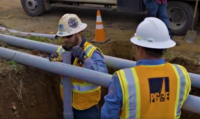BLM Advances 1 GW of Calif. Solar but Sector Growth Challenges Seen

The U.S. Bureau of Land Management has set a Sept. 6 deadline for public comment on the environmental impacts of three proposed solar power projects totaling nearly 1 GW to be built on more than 5,300 acres of public land in Riverside County, Calif.
As the clean energy sector expands to meet net-zero carbon emissions targets, challenges lie ahead, say government researchers and industry experts.
BLM said construction of the proposed Arica, Victory Pass and Oberon solar projects is set to start next spring and be complete by December 2023.
The first two projects, which would generate up to 465 MW of power with up to 400 MW of battery storage, are set to cost about $689 million and create more than 1,000 construction jobs, says San Francisco-based Clearway Energy Group, their developer.
In its comment request, BLM said it is analyzing both projects in one review because they are immediately adjacent, have similar environmental impacts and would share some infrastructure, including access roads and a generation tie-line from a shared switching station to the existing Southern California Edison Red Bluff substation.
Clearway says both projects have purchase power agreements in place.
The 500-MW Oberon project, being reviewed separately, is proposed by Intersect Power LLC, which says it will supply 200,000 homes.
The company says the cost of the project is confidential.
Oberon has been designed modularly, in collaboration with state natural resources agencies, to protect habitats, avoid migration corridors for desert wildlife and preserve the natural site, says developer spokesperson Cate Powers.
Contractor details have not been released for any of the projects.
The three projects are located in an area identified as suitable for renewable energy development under the Desert Renewable Energy Conservation Plan, a collaboration between the state and federal government that covers 10.8 million acres of public lands in seven desert regions in California.
Solar power could make up 40% of U.S. electrical generation and sustain as many as 1.5 million jobs by 2035, according to a preliminary report released Aug. 18 by the U.S. Energy Dept.’s National Renewable Energy Laboratory, which called it “the fastest-growing source of new electricity generation in the nation.” It has grown 4,000% in the past decade.
The report says solar capacity must accelerate by three to four times what it is currently to achieve a largely net-zero U.S. power sector by 2035.
But even in Nevada, which approved a measure on last year's ballot to transition to 50% clean energy by 2030, and which generates 28% of its utility-scale power from renewables, solar projects face risks.
Developers of the 850-MW Battle Born solar project, set to be built on 9,200 acres of the BLM-managed Moapa Valley north of Las Vegas, said last month they would cancel their agency application for the facility due to opposition from businesses, environmental groups and others, the Associated Press reported. One developer, Arevia Power, is still moving ahead with a 690-MW solar project about 20 miles away.
Sector proponents say solar expansion would require Congress to extend project investment and production tax credits, as well as set new incentives for storage and transmission upgrades.
“As the report makes clear, seizing this growth opportunity will require rapid transformation of the power sector and significant investment in a 21st century grid,” said Gregory Wetstone, president and CEO of the American Council on Renewable Energy, in a statement. He notes need to “move the renewable sector beyond the endless cycle of temporary stopgap measures to a stable, predictable, and long-term clean energy tax platform.” Other industry lobbyists point to changes needed in U.S. trade policy related to imports of project components.
But, according to industry experts queried by S&P Global, other steps include incentives to power suppliers to meet annual clean electricity goals, as well as more R&D, domestic supply chain investment and attention to current transmission barriers.
Scott Miller, Western Power Trading Forum executive director, said the NREL report “does not address the need ... to support moving power from areas with surplus energy to those without it.”





